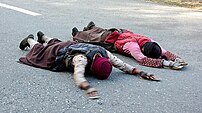|
I think pretty much every major religion requires some type of sacrifice. We are familiar with some of them – giving our time in service or our money as alms or charity. But for most of us I bet the sacrifice of a pilgrimage is a little more extreme or even unheard of. For many Christians and Jews a trip to Jerusalem or a holy site in Europe is a pilgrimage, Muslims are required to visit Mecca during their life (or at least try) and many Eastern religions have holy sites as well.
Again you ask, how does this apply to running? I’ve never taken a pilgrimage and I don’t think it would be safe for me to run around any of the sacred sites I mentioned above. But combining all we have talked about so far – prayer, sanctuary, meditation, etc – pilgrimage is a major step, think of it as a spiritual quest.
As I was reading the background on pilgrimage in Running the Sacred Art, my mind started drifting to the marathon. Yes, Warren Kay agrees with me on that and links the two!
To ensure we are all the same page, Kay defines a pilgrimage as a journey made to a sacred shrine for spiritual purposes, such as healing, blessing, prestige, camaraderie, and a source of faith. He sees three major steps to a pilgrimage – separation from the routine, being at the shrine, and the journey home. The following quote about pilgrimage really hit me as being similar to many of my running experiences:
You find yourself among like-minded people who are making a similar quest, and through the journey, you recognize and respond to the humanity in them. You are likely to open up easily, talk to strangers and engage them as people, even as friends. This realization of community can become so profound that you may also experience a compassion for the whole of humanity.
Does that sound familiar to you? Let me quickly highlight the comparison of a marathon (or other run) to a pilgrimage.
- For many the marathon is a “holy grail” to obtain. They have a specific location they want to race it at with a purpose behind it.
- You go through a long process of training, sacrificing and separating yourself from others to accomplish it.
- You often travel to a different city for a race, meeting and interacting with other runners at the expo and pasta dinners.
- The level of excitement and community grows as you jam into the starting corrals.
- You become separated from the mere mortals (aka spectators) as you run the course.
- Everyone running beside you has the goal of accomplishing this 26.2 mile quest and often will help you make it if you stumble.
- Crossing the finish line brings ecstatic joy, even as you collapse into the waiting arms of medical personnel.
- You become transformed by calling yourself a marathoner.
I want to make sure I don’t take too lightly the idea of a pilgrimage because I have heard from others that it can be a profound experience. I know in accomplishing the marathon my perspective on running and life has changed even if just a little. Previously we talked about running as sanctuary, but sanctuary and pilgrimage are different.
Kay describes the difference simply. A sanctuary run is like going to church – you go regularly because it is convenient. It can be powerful but is also part of the routine. A pilgrimage run is something more unique like visiting the tomb were Jesus was buried. It is unique and not part of the routine. A pilgrimage run could be going back to your old stomping grounds and running an old trail or cross country course from your past, like I did over Christmas. It was a time of remembering and reflecting, even though I didn’t necessarily intend that at the start.
Have you ever gone on a pilgrimage run? Could your first marathon experience equate to a pilgrimage?
[tags] Warren Kay, Sacred Art of Running, Pilgrimage, Spiritual [/tags]

![Reblog this post [with Zemanta]](https://i0.wp.com/img.zemanta.com/reblog_e.png?w=625)



